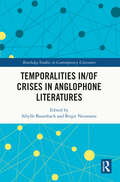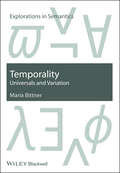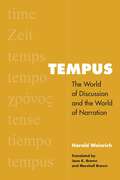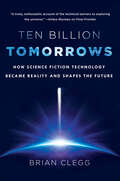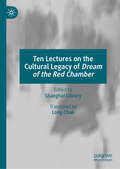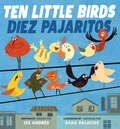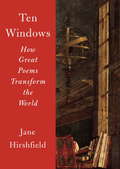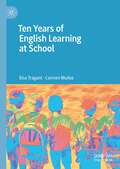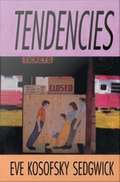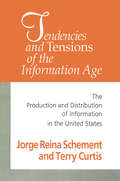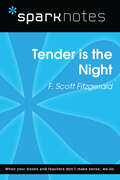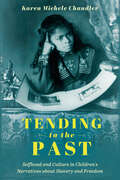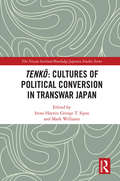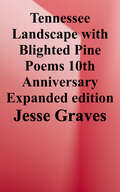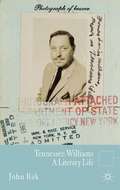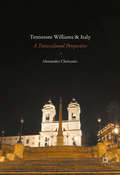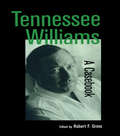- Table View
- List View
Temporalities in/of Crises in Anglophone Literatures (Routledge Studies in Contemporary Literature)
by Sibylle Baumbach Birgit NeumannLiterary works play a crucial role in modelling and conceptualising temporalities. This becomes particularly apparent in times of crises, which put conventionalised temporal patterns and routines under pressure. During crises, past, present, and future appear to collapse into each other and give way to temporal disjunction and rupture. Offering pluralised and context-sensitive approaches to temporalities in and of crises, this volume explores how literature’s engagement with crises suggests both the need for and possibility of rethinking ‘time’. The volume is committed to examining the affordances of specific genres and their potential in pointing beyond temporalities of crises to facilitate a sense of futurity. Individual essays are grounded in recent theories of temporality and literary form, which are related to novel advancements in ecocriticism, queer studies, affect theory, and postcolonial studies. The chapters cover a broad range of examples from different literary genres to reveal the knowledge of literature about temporalities in and of crises.
Temporalities in/of Crises in Anglophone Literatures (Routledge Studies in Contemporary Literature)
by Sibylle Baumbach Birgit NeumannLiterary works play a crucial role in modelling and conceptualising temporalities. This becomes particularly apparent in times of crises, which put conventionalised temporal patterns and routines under pressure. During crises, past, present, and future appear to collapse into each other and give way to temporal disjunction and rupture. Offering pluralised and context-sensitive approaches to temporalities in and of crises, this volume explores how literature’s engagement with crises suggests both the need for and possibility of rethinking ‘time’. The volume is committed to examining the affordances of specific genres and their potential in pointing beyond temporalities of crises to facilitate a sense of futurity. Individual essays are grounded in recent theories of temporality and literary form, which are related to novel advancements in ecocriticism, queer studies, affect theory, and postcolonial studies. The chapters cover a broad range of examples from different literary genres to reveal the knowledge of literature about temporalities in and of crises.
Temporality: Universals and Variation (Explorations in Semantics)
by Maria BittnerTemporality surveys the ways in which languages of different types refer to past, present, and future events, through an in-depth examination of four major language types: tense-based English, tense-aspect-based Polish, aspect-based Chinese, and mood-based Kalaallisut. Cutting-edge research on directly compositional dynamic semantics of languages with and without grammatical tense New in-depth analysis of temporal, aspectual, modal, as well as nominal discourse reference Presents a novel logical language for representing linguistic meaning (Update with Centering) Develops a unified theory of tense, aspect, mood, and person as different types of ‘grammatical centering systems’
Tempus: The World of Discussion and the World of Narration (Verbal Arts: Studies in Poetics)
by Harald WeinrichA foundational book by one of the most distinguished German humanists of the last half century, Tempus joins cultural linguistics and literary interpretation at the hip. Developing two controversial theses—that sentences are not truly meaningful in isolation from their contexts and that verb tenses are primarily indicators not of time but of the attitude of the speaker or writer—Tempus surveys a dazzling array of ancient and modern texts from famous authors as well as casual speakers of German, French, Italian, Spanish, Portuguese, Latin, and English, with a final chapter extending the observations to Greek, Russian, and world languages.A classic in German and long available in many other languages, Tempus launched a new discipline, text linguistics, and established a unique career that was marked by precise observation, sensitive cultural outreach, and practical engagement with the situation of migrants. Weinrich’s robust and lucid close readings of famous and little-known authors from all the major languages of western Europe expand our literary horizons and challenge our linguistic understanding.
Ten Billion Tomorrows: How Science Fiction Technology Became Reality and Shapes the Future
by Brian CleggAn exciting book about real-life technology derived from science fiction and its impact on the world.Science fiction is a vital part of popular culture, influencing the way we all look at the world. TV shows like Star Trek and movies from Forbidden Planet to Inception have influenced scientists to enter the profession and have shaped our futures. Science fiction doesn't set out to predict what will happen - it's far more about how human beings react to "What if?…" - but it is fascinating to see how science fiction and reality sometimes converge, sometimes take extraordinarily different paths.Ten Billion Tomorrows brings to life a whole host of science fiction topics, from the virtual environment of The Matrix and the intelligent computer HAL in 2001, to force fields, ray guns and cyborgs. We discover how science fiction has excited us with possibilities, whether it is Star Trek's holodeck inspiring makers of iconic video games Doom and Quake to create the virtual interactive worlds that transformed gaming, or the strange physics that has made real cloaking devices possible. Mixing remarkable science with the imagination of our greatest science fiction writers, Ten Billion Tomorrows will delight science fiction lovers and popular science devotees alike.
Ten Lectures on the Cultural Legacy of Dream of the Red Chamber
by Shanghai LibraryThis book offers a profound exploration of the classic Chinese novel Dream of the Red Chamber, recognized as a masterpiece of traditional Chinese literature. Developed from a series of lectures at the Shanghai Library, the text features insights from ten prominent scholars, including Wang Meng and Bai Xianyong, addressing themes such as poetic aesthetics, tragic beauty, female perspectives, and cultural symbolism. The chapters delve into multifaceted interpretations, connecting literature with cultural, philosophical, and artistic heritage. Designed for both specialists and general readers, this book enriches understanding of one of the world’s literary treasures, blending cultural appreciation with critical scholarship. It highlights the novel’s timeless narrative, intricate character portrayals, social critique, and artistic sophistication, offering a gateway to understanding Chinese culture’s enduring legacy and its global significance. Readers will discover rich analyses, compelling arguments, and fresh perspectives that deepen their appreciation for this unparalleled literary classic.
Ten Little Birds / Diez Pajaritos (Ebook)
by Andrés SalgueroCount to 10 and back again with Latin Grammy Award-winning children's musical duo 123 Andrés in this bilingual ebook!The popular song from 123 Andrés' Latin Grammy Award-winning album is cleverly and beautifully brought to life in this bright, bouncy book! Each of the 10 birds is given a fun and silly personality, and children will love to follow along as each flies away -- and escapes a lurking kitty!123 Andrés are gifted lyricists and storytellers, and this bilingual board book perfectly captures their energy and charm. Pura Belpré Illustration Honor recipient Sara Palacios's gorgeous illustrations elevate the text and make this book a must-have for any home or school library!
Ten Steps to Advancing College Reading Skills (4th edition)
by John LanganThis book is suitable for the core or advanced developmental reading course offered at most colleges. The key features include: Focus on the basics, Frequent practice and feedback, High interest level, Ease of use, Integration of skills, Online exercises, Thinking activities, Supplementary materials e.t.c.
Ten Steps to Building College Reading Skills
by John LanganTen Steps to Building College Reading Skills by John Langan
Ten Steps to Mastering College Reading Skills
by John LanganThe purpose of Ten Steps to Mastering College Reading Skills (titled Ten Steps to Advanced Reading in its first two editions) is to develop effective reading and clear thinking.
Ten Windows
by Jane HirshfieldA dazzling collection of essays on how the best poems work, from the master poet and essayist "Poetry," Jane Hirshfield has said, "is language that foments revolutions of being." In ten eloquent and highly original explorations, she unfolds and explores some of the ways this is done--by the inclusion of hiddenness, paradox, and surprise; by a perennial awareness of the place of uncertainty in our lives; by language's own acts of discovery; by the powers of image, statement, music, and feeling to enlarge in every direction. The lucid understandings presented here are gripping and transformative in themselves. Investigating the power of poetry to move and change us becomes in these pages an equal investigation into the inhabitance and navigation of our human lives. Closely reading poems by Dickinson, Bashō, Szymborska, Cavafy, Heaney, Bishop, and Komunyakaa, among many others, Hirshfield reveals how poetry's world-making takes place: word by charged word. By expanding what is imaginable and sayable, Hirshfield proposes, poems expand what is possible. Ten Windows restores us at every turn to a more precise, sensuous, and deepened experience of our shared humanity and of the seemingly limitless means by which that knowledge is both summoned and forged.From the Hardcover edition.
Ten Windows: How Great Poems Transform the World
by Jane HirshfieldA dazzling collection of essays on how the best poems work, from the master poet and essayist “Poetry,” Jane Hirshfield has said, “is language that foments revolutions of being.” In ten eloquent and highly original explorations, she unfolds and explores some of the ways this is done—by the inclusion of hiddenness, paradox, and surprise; by a perennial awareness of the place of uncertainty in our lives; by language’s own acts of discovery; by the powers of image, statement, music, and feeling to enlarge in every direction. The lucid understandings presented here are gripping and transformative in themselves. Investigating the power of poetry to move and change us becomes in these pages an equal investigation into the inhabitance and navigation of our human lives. Closely reading poems by Dickinson, Bashō, Szymborska, Cavafy, Heaney, Bishop, and Komunyakaa, among many others, Hirshfield reveals how poetry’s world-making takes place: word by charged word. By expanding what is imaginable and sayable, Hirshfield proposes, poems expand what is possible. Ten Windows restores us at every turn to a more precise, sensuous, and deepened experience of our shared humanity and of the seemingly limitless means by which that knowledge is both summoned and forged.From the Hardcover edition.
Ten Years of English Learning at School
by Carmen Muñoz Elsa TragantThis book is based on a longitudinal study involving learners of English as a foreign language from their first year in primary education to their last year in compulsory secondary education. Some of the chapters report on the whole sample initially drawn from five primary schools and some are based on a sample of focal learners. These focal learners were followed in secondary school (grades 7 and 10). One of the main aims of the book is capturing change over time regarding the learners’ language perceptions and awareness, oral and written language development, learners’ attitudes and motivation, and their language learning trajectories. The longitudinal nature of the data also allows identification of internal and external factors on learners’ linguistic outcomes. The book draws on a wealth of data sources (self-reported data, classroom observations, institutional data, language tests and tasks), participants (learners, teachers, parents), several testing times and both qualitative and quantitative analyses. The book will be of interest to educators and scholars working on such areas as language pedagogy, language development and awareness as well as individual differences.
Tendencies
by Eve Kosofsky SedgwickTendencies brings together for the first time the essays that have made Eve Kosofsky Sedgwick "the soft-spoken queen of gay studies" (Rolling Stone). Combining poetry, wit, polemic, and dazzling scholarship with memorial and autobiography, these essays have set new standards of passion and truthfulness for current theoretical writing. The essays range from Diderot, Oscar Wilde, and Henry James to queer kids and twelve-step programs; from "Jane Austen and the Masturbating Girl" to a performance piece on Divine written with Michael Moon; from political correctness and the poetics of spanking to the experience of breast cancer in a world ravaged and reshaped by AIDS. What unites Tendencies is a vision of a new queer politics and thought that, however demanding and dangerous, can also be intent, inclusive, writerly, physical, and sometimes giddily fun.
Tendencies and Tensions of the Information Age: Production and Distribution of Information in the United States
by Jorge Reina Schement Terry CurtisThe development of technology and the hunger for information has caused a wave of change in daily life in America. Nearly every American's environment now consists of cable television, video cassette players, answering machines, fax machines, and personal computers. Schement and Curtis argue that the information age has evolved gradually throughout the twentieth century. National focus on the production and distribution of information stems directly from the organizing principles and realities of the market system, not from a revolution sparked by the invention of the computer.Now available in paperback, Tendencies and Tensions of the Information Age, brings together findings from many disciplines, including classical studies, etymology, political sociology, and macroeconomics. This valuable resource will be enjoyed by sociologists, historians, and scholars of communication and information studies.
Tender is the Night (SparkNotes Literature Guide Series)
by SparkNotesTender is the Night (SparkNotes Literature Guide) by F. Scott Fitzgerald Making the reading experience fun! Created by Harvard students for students everywhere, SparkNotes is a new breed of study guide: smarter, better, faster. Geared to what today's students need to know, SparkNotes provides: *Chapter-by-chapter analysis *Explanations of key themes, motifs, and symbols *A review quiz and essay topicsLively and accessible, these guides are perfect for late-night studying and writing papers
Tending to the Past: Selfhood and Culture in Children's Narratives about Slavery and Freedom (Children's Literature Association Series)
by Karen Michele ChandlerIn many popular depictions of Black resistance to slavery, stereotypes around victimization and the heroic efforts of a small number of individuals abound. These ideas ignore the powers of ordinary families and obscure the systematic working of racism. Tending to the Past: Selfhood and Culture in Children’s Narratives about Slavery and Freedom examines Black-authored historical novels and films for children that counter this distortion and depict creative means by which ordinary African Americans survived slavery and racism in early America. Tending to the Past argues that this important, understudied historical writing—freedom narratives—calls on young readers to be active, critical thinkers about the past and its legacies within the present. The book examines how narratives by children’s book authors, such as Joyce Hansen, Julius Lester, Marilyn Nelson, and Patricia McKissack, and the filmmakers Charles Burnett and Zeinabu irene Davis, were influenced by Black cultural imperatives, such as the Black Arts Movement, to foster an engaged, culturally aware public. Through careful analysis of this rich body of work, Tending to the Past thus contributes to ongoing efforts to construct a history of Black children’s literature and film attuned to its range, specificity, and depths. Tending to the Past provides illuminating interpretations that will help scholars and educators see the significance of the freedom narratives’ reconstructions in a neoliberal era, a time of shrinking opportunities for many African Americans. It offers models for understanding the powers and continuing relevance of the Black child’s creative agency and the Black cultural practices that have fostered it.
Tenkō: Cultures Of Political Conversion In Transwar Japan (Nissan Institute/Routledge Japanese Studies)
by Irena Hayter; George T. Sipos; Mark WilliamsThis book approaches the concept of tenkō (political conversion) as a response to the global crisis of interwar modernity, as opposed to a distinctly Japanese experience in postwar debates. Tenkō connotes the expressions of ideological conversion performed by members of the Japanese Communist Party, starting in 1933, whereby they renounced Marxism and expressed support for Japan’s imperial expansion on the continent. Although tenkō has a significant presence in Japan’s postwar intellectual and literary histories, this contributed volume is one of the first in Englishm language scholarship to approach the phenomenon. International perspectives from both established and early career scholars show tenkō as inseparable from the global politics of empire, deeply marked by an age of mechanical reproduction, mediatization and the manipulation of language. Chapters draw on a wide range of interdisciplinary methodologies, from political theory and intellectual history to literary studies. In this way, tenkō is explored through new conceptual and analytical frameworks, including questions of gender and the role of affect in politics, implications that render the phenomenon distinctly relevant to the contemporary moment. Tenkō: Cultures of Political Conversion in Transwar Japan will prove a valuable resource to students and scholars of Japanese and East Asian history, literature and politics.
Tennessee Landscape with Blighted Pine: Poems
by Jesse GravesFirst released in 2011, Tennessee Landscape with Blighted Pine was the debut poetry collection from Tennessee poet Jesse Graves and was awarded the 2011 Weatherford Award in Poetry from Berea College, the Book of the Year in Poetry Award from the Appalachian Writers' Association, and the Thomas and Lillie D. Chaffin Award for Appalachian Writing.
Tennessee Performance Coach, English Language Arts, [Grade] 4
by Triumph LearningNIMAC-sourced textbook
Tennessee Performance Coach, English Language Arts, [Grade] 5
by Triumph LearningNIMAC-sourced textbook
Tennessee Williams
by John S. BakPerfect for students of English Literature, Theatre Studies and American Studies at college and university, The Theatre of Tennessee Williams provides a lucid and stimulating analysis of Willams' dramatic work by one of America's leading scholars. With the centennial of his birth celebrated amid a flurry of conferences devoted to his work in 2011, and his plays a central part of any literature and drama curriculum and uibiquitous in theatre repertoires, he remains a giant of twentieth century literature and drama. In Brenda Murphy's major study of his work she examines his life and career and provides an analysis of more than a score of his key plays, including in-depth studies of major works such as A Streetcar Named Desire, The Glass Menagerie, Cat on a Hot Tin Roof and others. She traces the artist figure who features in many of Williams' plays to broaden the discussion beyond the normal reference points. As with other volumes in Methuen Drama's Critical Companions series, this book features too essays by Bruce McConachie, John S. Bak, Felicia Hardison Londr#65533; and Annette Saddik, offering perspectives on different aspects of Williams' work that will assist students in their own critical thinking.
Tennessee Williams and Italy
by Alessandro ClericuzioThis book reveals for the first time the import of a hugenetwork of connections between Tennessee Williams and the country closest to his heart, Italy. America's most thought-provoking playwright loved Italy morethan any other country outside the U. S. and was deeply influenced by itsculture for most of his life. Anna Magnani's film roles in the 1940s, ItalianNeo-realist cinema, the theatre of Eduardo De Filippo, as well as the actualexperience of Italian life and culture during his long stays in the countrywere some of the elements shaping his literary output. Through his lover FrankMerlo, he also had first-hand knowledge of Italian-American life in Brooklyn. Tracing the establishment of his reputation with theItalian intelligentsia, as well as with theatre practitioners and withgenerations of audiences, the book also tells the story of a momentouscollaboration in the theatre, between Williams and Luchino Visconti, who had todefy the unceasing control Italian censorship exerted on Williams for decades.
Tennessee Williams and the Theatre of Excess
by Annette J. SaddikThe plays of Tennessee Williams' post-1961 period have often been misunderstood and dismissed. In light of Williams' centennial in 2011, which was marked internationally by productions and world premieres of his late plays, Annette J. Saddik's new reading of these works illuminates them in the context of what she terms a 'theatre of excess', which seeks liberation through exaggeration, chaos, ambiguity, and laughter. Saddik explains why they are now gaining increasing acclaim, and analyzes recent productions that successfully captured elements central to Williams' late aesthetic, particularly a delicate balance of laughter and horror with a self-consciously ironic acting style. Grounding the plays through the work of Bakhtin, Artaud, and Kristeva, as well as through the carnivalesque, the grotesque, and psychoanalytic, feminist, and queer theory, Saddik demonstrates how Williams engaged the freedom of exaggeration and excess in celebration of what he called 'the strange, the crazed, the queer'.
Tennessee Williams: A Casebook
by Robert F. GrossTennessee Williams' plays are performed around the world, and are staples of the standard American repertory. His famous portrayals of women engage feminist critics, and as America's leading gay playwright from the repressive postwar period, through Stonewall, to the growth of gay liberation, he represents an important and controversial figure for queer theorists. Gross and his contributors have included all of his plays, a chronology, introduction and bibliography.
